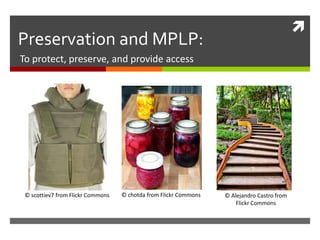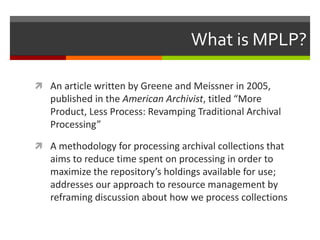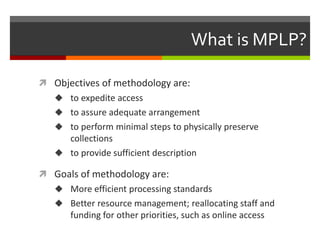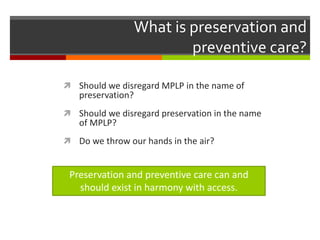Preservation and MPLP: To protect, preserve and provide access
- 1. ’ā¼ Preservation and MPLP: To protect, preserve, and provide access ┬® chotda from Flickr Commons┬® scottiev7 from Flickr Commons ┬® Alejandro Castro from Flickr Commons
- 2. What is MPLP? ’ā¼ An article written by Greene and Meissner in 2005, published in the American Archivist, titled ŌĆ£More Product, Less Process: Revamping Traditional Archival ProcessingŌĆØ ’ā¼ A methodology for processing archival collections that aims to reduce time spent on processing in order to maximize the repositoryŌĆÖs holdings available for use; addresses our approach to resource management by reframing discussion about how we process collections
- 3. What is MPLP? ’ā¼ Objectives of methodology are: ’üĄ to expedite access ’üĄ to assure adequate arrangement ’üĄ to perform minimal steps to physically preserve collections ’üĄ to provide sufficient description ’ā¼ Goals of methodology are: ’üĄ More efficient processing standards ’üĄ Better resource management; reallocating staff and funding for other priorities, such as online access
- 4. What is MPLP? ’ā¼ Assumptions made by authors of MPLP ’üĄ Most repositories have a large backlog of large, 20th century manuscript or records collections (meaning, paper-based records) ’üĄ Most repositories resemble government, academic or university archives ’üĄ Access resembles researchers in a reading room receiving one box at a time, such as in an academic research library or government records office
- 5. What is MPLP? ’ā¼ Does this describe your collections? ’ā¼ Does this describe the problems you face as collection managers? (Please raise your hand if this is where you find yourself.)
- 6. What is MPLP? ’ā¼ Assumptions (conŌĆÖt) ’üĄ Preservation activity includes only removing rusty fasteners, refoldering, reboxing and environmental monitoring and control
- 7. What is preservation and preventive care? ’ā¼ SAA Glossary of Archival and Records Terminology: ’üĄ preservation: n. ~ the professional discipline of protecting materials by minimizing chemical and physical deterioration and damage to minimize the loss of information and to extend the life of cultural property. ’üĄ preventive care: n. ~ The mitigation of deterioration and damage through the formulation and implementation of policies and procedures for appropriate environmental conditions; handling and maintenance during storage, exhibition, packing, transport, and use; integrated pest management; emergency preparedness and response; and reformatting and duplication.
- 8. What is preservation and preventive care? ’ā¼ Implementation of a preventive care program includes 5 key components: ’üĄ Environmental control ’üĄ Policies and procedures for handling, use and for maintenance for storage, exhibition, packing and transport ’üĄ Emergency preparedness and response ’üĄ Integrated pest management ’üĄ Reformatting and duplication Laura McCann, ŌĆ£Preservation as Obstacle or Opportunity? Rethinking the Preservation- Access Model in the Age of MPLP.ŌĆØ Journal of Archival Organization, 11:23-48, 2013.
- 9. ReconcilingTension of Preservation and Access ’ā¼ McCann, ŌĆ£Preservation as Obstacle or Opportunity?ŌĆØ ’üĄ ŌĆ£Application of risk management is crucial to ensure that collections that are minimally processed are accessible for future users.ŌĆØ
- 10. ReconcilingTension of Preservation and Access ’ā¼ Good appraisal and acquisition procedures ’ā¼ Survey collections to collect format and condition information and other risk factors ’ā¼ Set preservation baseline for processing and document in guidelines for staff/volunteers/interns ’ā¼ Review actions and policies (every 3-5 years)
- 11. What is preservation and preventive care? ’ā¼ Should we disregard MPLP in the name of preservation? ’ā¼ Should we disregard preservation in the name of MPLP? ’ā¼ Do we throw our hands in the air? Preservation and preventive care can and should exist in harmony with access.
- 12. ReconcilingTension of Preservation and Access Policy’āĀAssessment’āĀDecision’āĀAction’āĀReview The continuum
- 13. Thank you Jennifer Waxman [Archives] Consultant j.r.waxman@gmail.com
Editor's Notes
- #2: Hello. My name is Jennifer Waxman. Thank you Beth for putting this panel together. I am excited to be here, this is my first ATALM. The title of my talk is Preservation and MPLP: To protect, preserve, and provide access. Today I will talk to you as an archivist and preservation specialist about the perceived tensions between preservation and access with regard to the recently introduced and widely-adopted methodology called More Product, Less Process. Traditionally preservation activities have been seen as competing with access, that archivists inefficiently process collections by spending too much time rehousing material, thus holding collection resources back from users. I want to look at the assumptions made in this article about preservation activities and explain how implementation of a holistic preservation program can set the stage to accommodate efficient processing methods. First, I will introduce MPLP and then I will review preservation and preventive conservation; I will then discuss how both preservation and MPLP both advocate better resource management and can be exist together without sacrificing access or collections care. But here is my disclaimer. I havenŌĆÖt ever worked with tribal collections and archives, but IŌĆÖve been doing some reading, attended some sessions by tribal archivists at SSA, and I talked to a few of you about your issues as collection managers. Therefore, IŌĆÖve tried to make this talk educational, practical and more universal if not general for all types of folks involved in cultural heritage resource management.
- #3: What is MPLP? Can I get a show of hands from those of you who are familiar with MPLP and its basic approach to more efficient processing? MPLP is an article written by Mark Greene and Dennis Meissner in 2005 published in the American Archivist title ŌĆ£More Product, Less Process: Revamping Traditional Archival Processing.ŌĆØ In this article Greene and Meissner propose a new approach to processing collections that aims to reduce time spent on processing in order to maximize researchersŌĆÖ access to collections. It addresses our approach to resource management by reframing the discussion about what processing archivists actually spend their time doing and how collection managers allocated their resources.
- #4: The objectives of this methodology are: to expedite access, to assure adequate arrangement, to perform minimal steps to physically preserve collections, and to provide sufficient description. The goals of this methodology are: to achieve more efficient processing standards and to achieve better resource management that can allow collection managers to reallocate staff and funding into other priorities, such as creating new, minimal description standards and providing online access. Greene and Meissner propose archivists also spend less time on arrangement and description, and that has sparked numerous discussions about recreating the finding aid and other arrangement issues. I believe my co-panelists will discuss this in their talk.
- #5: Some assumptions made by the authors of MPLP include most repositories having large backlogs of large 20th century manuscript or records collections; most repositories resemble government or academic archive and research collections; and, that access resembles researchers in a well-monitored reading room receiving one box at a time, such as in an academic library or government records office.
- #6: Does this characterize your collections? Does this describe the problems you face as collection managers? Please raise your hand is this applies to you. I am curious to know how many tribal archivists find themselves up against major backlogs of large paper-based collections.
- #7: Back to preservation, Greene and Meissner make the assumption that an archivistŌĆÖs only preservation activity is removal of rusty fasteners, refoldering, reboxing and doing environmental control. Greene and Meissner limit their definition of preservation to these few actions, and they question why we even do them at all if you have environmental controls. This is a problem. Preservation is more than these few activities and this narrow view of preservation that can mislead archivists into thinking that having an HVAC system is going to save their collections. We know there are not enough resources in the world to treat every document or artifact. And not all documents, artifacts or collections warrant such attention. That is why it is important to know your collections and the risks and challenges you face. That will help you when making decisions about implementing MPLP, especially if you face pressure from you administration to get your backlogs out there. This may not be news to some of you, but when it comes down to faster processing versus preservation, it is important to remind ourselves that it is a balancing act and one size does not fit all.
- #8: What is Preservation and preventive care? Preservation: n. ~ the professional discipline of protecting materials by minimizing chemical and physical deterioration and damage to minimize the loss of information and to extend the life of cultural property. As archivists and collection managers we have an ethical and moral responsibility to extend the life of cultural property. Obviously, this inspires debate about how we do this and the extent that we put our time and resources into it. The field of conservation and preservation administrators has, over time, has defined more clearly what it means to ŌĆ£preserve.ŌĆØ Preventive care: n. ~┬ĀThe mitigation of deterioration and damage through the formulation and implementation of policies and procedures for appropriate environmental conditions; handling and maintenance during storage, exhibition, packing, transport, and use; integrated pest management; emergency preparedness and response; and reformatting and duplication. Greene and Meissner assume that all of this has been done by the archivists already, but we know, in the real world, that establishing procedures and protocols is an ongoing process to collection development and management.
- #9: LetŌĆÖs look a little more closely at the five key elements of a preventive care program: Environmental controlŌĆöthis is not just putting data loggers in your collection storage areas. Be sure to analyze the data and work with facilities managers to mitigate problems. What are your set points? Do you have fluctuation in temp and RH? Are there pockets of low or no air circulation that could be an opportune area for mold to grow? Policies and procedures: very important to set protocols for how you handle material in all scenarios. Examples of policies and procedures includes protocols on accessioning collections, processing manuals for staff, security protocol in the reading room, and guidelines for exhibitions and material transport. Documentation is very important! Write it down so there is consistency. Emergency preparedness and response: a keystone in protecting collections. Know the risks your facility faces, whether it be earthquakes or floods. DonŌĆÖt forget about protocols and procedures for mold discovery and response to leaks. Integrated pest management: if you have traps set for pests, are you monitoring them? Do you have good policies about food consumption in the building for staff and volunteers to follow? Reformatting and duplication: documentation about handling materials comes in handy here and determining the type and kind of collections that benefit from reformatting helps you evaluate your collections in a needs-based scenario. These five elements were discussed in Laura McCannŌĆÖs article in the Journal of Archival Organization from the fall of last year. She goes on to say:
- #10: How do we reconcile the tension between preservation and access? Preservation is about risk management, and preventive care outlines the approach you can take as collection managers to handle risk. Laura McCann reminds us in her article that ŌĆ£application of risk management is crucial to ensure that collections that are minimally processed are accessible for future users.ŌĆØ Both MPLP and preventive care should be seen as methods to risk management that benefits collections as a whole with the goal of long-term access.
- #11: LetŌĆÖs look at preservation activities that you can incorporate into your everyday archival functions and aid you in risk management beyond simple removal of rusty fasteners, reboxing, and refoldering. Good appraisal and acquisition procedures: during acquisition you can use a checklist to collect condition data about a collection; this will aid you in the decision making process about what collections can be managed with more efficient processing techniques. I will give you a hint: the most appropriate collections for MPLP are homogenous in format and arrive at the archive generally well organized by the creator, have few privacy concerns, contain few culturally sensitive objects and few instances of high level deterioration or other item-level preservation concerns. If you donŌĆÖt know what you have in your collections, implement a condition survey to collect data that can help you formulate guidelines and policies based on the nature of your collections. It will also help you create a preservation plan and provide data for which you can write grants or ask for funding. From these surveys, you can also set a matrix for levels of processing based on intellectual value, research value, institutional value, and needs of the materials themselves. For staff, volunteers and interns, set a preservation baseline for collections that meet the criteria set from your assessments and knowledge of collection issues. Create documentation for staff to follow. Review your policies and decisions frequently, every 2, 3 or 5 years. Things change and you may have to adjust as needed.
- #13: Consider both preservation and access as a continuum for which you have to set policies, assess the situation, make decisions, perform actions, and review.












![Thank you
Jennifer Waxman
[Archives] Consultant
j.r.waxman@gmail.com](https://image.slidesharecdn.com/atalmpreservationandmplp-150731163028-lva1-app6891/85/Preservation-and-MPLP-To-protect-preserve-and-provide-access-13-320.jpg)